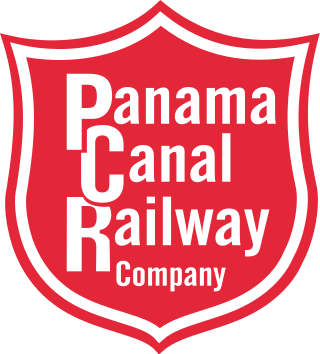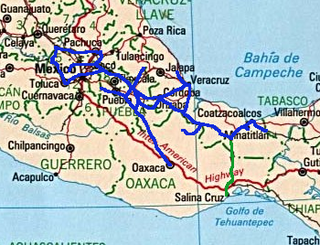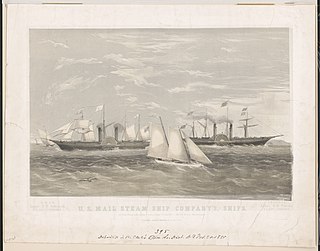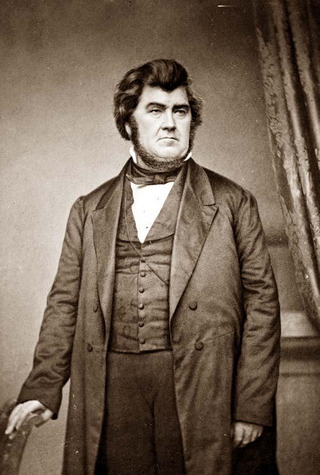
The history of Panama includes the history of the Isthmus of Panama prior to European colonization.

The Panama Canal Railway is a railway line linking the Atlantic Ocean to the Pacific Ocean in Central America. The route stretches 47.6 miles (76.6 km) across the Isthmus of Panama from Colón (Atlantic) to Balboa. Because of the difficult physical conditions of the route and state of technology, the construction was renowned as an international engineering achievement, one that cost US$8 million and the lives of an estimated 5,000 to 10,000 workers. Opened in 1855, the railway preceded the Panama Canal by half a century; the railway was vital in assisting the construction of the canal in the early 1900s. With the opening of the canal, the railroad's route was changed as a result of the creation of Gatun Lake, which flooded part of the original route. Following World War II, the railroad's importance declined and much of it fell into a state of neglect until 1998, when a project to rebuild the railroad to haul intermodal traffic began; the new railroad opened in 2001.

The Isthmus of Panama, also historically known as the Isthmus of Darien, is the narrow strip of land that lies between the Caribbean Sea and the Pacific Ocean, linking North and South America. It contains the country of Panama and the Panama Canal. Like many isthmuses, it is a location of great geopolitical and strategic importance.

The Accessory Transit Company was a company set up by Cornelius Vanderbilt and others during the California Gold Rush in the 1850s, to transport would-be prospectors from the east coast of the United States to the west coast.

The establishment of America's transcontinental rail lines securely linked California to the rest of the country, and the far-reaching transportation systems that grew out of them during the century that followed contributed to the state's social, political, and economic development. When California was admitted as a state to the United States in 1850, and for nearly two decades thereafter, it was in many ways isolated, an outpost on the Pacific, until the first transcontinental railroad was completed in 1869.

The maritime history of California can be divided into several periods: the Native American period; European exploration period from 1542 to 1769; the Spanish colonial period, 1769 to 1821; the Mexican period, 1821 to 1847; and United States statehood period, which continues to the present day. In the history of the California coast, the use of ships and the Pacific Ocean has historically included water craft, fisheries, shipbuilding, Gold Rush shipping, ports, shipwrecks, naval ships and installations, and lighthouses.

The Watermelon Riot occurred on the evening of April 15, 1856, in Panama City, then the capital of Panama State in the Republic of New Granada. After an American took a slice of watermelon from a street vendor and refused to pay for it, a verbal altercation ensued and then quickly escalated when shots were fired. An angry mob of locals converged on the site and began fighting with the Americans. Before order could be restored, at least fifteen Americans and two Panamanians were killed. American businesses, including the railroad station, were extensively damaged or destroyed.

The Ferrocarril del Istmo de Tehuantepec(Ferrocarril del Istmo de Tehuantepec, S.A. de C.V.), also known as Ferrocarril Transístmico or simply Ferroistmo, is part of the Interoceanic Corridor of the Isthmus of Tehuantepec, owned by the Mexican government, that crosses the Isthmus of Tehuantepec between Puerto Mexico, Veracruz, and Salina Cruz, Oaxaca. It is leased to Ferrocarril del Sureste FERROSUR.

Henry Larcom Abbot was a military engineer and career officer in the United States Army. He served in the Union Army during the American Civil War and was appointed brevet brigadier general of volunteers for his contributions in engineering and artillery. In 1866 he received additional brevet appointments as major general of volunteers and brigadier general in the Regular Army. He conducted several scientific studies of the Mississippi River with captain, later Major General Andrew A. Humphreys. After his retirement, Abbot served as a consultant for the locks on the Panama Canal. He was elected a Fellow of the American Academy of Arts and Sciences in 1863.

Rail transport in Central America consists of several isolated railroad lines with freight or passenger service. The most famous one is the Panama Canal Railway, the oldest transcontinental railroad in the world, connecting Panama City with Colón since 1855. Other railroads in Belize, Guatemala, Honduras, El Salvador, Nicaragua, Costa Rica and Panama were built by private and public investors mainly to facilitate the transport of local agricultural produce to export markets and harbors. Their market share and profitability went into decline in the second half of the twentieth century and most lines have been decommissioned by the end of the 1990s. As of 2018, railroads operate locally in Honduras, Costa Rica and Panama only; all rail transport has been suspended in Belize, El Salvador, Guatemala and Nicaragua. The railways still operating do not cross national borders.

U.S. Mail Steamship Company was a company formed in 1848 by George Law, Marshall Owen Roberts and Bowes R. McIlvaine to assume the contract to carry the U. S. mails from New York City, with stops in New Orleans and Havana, to the Isthmus of Panama for delivery in California. The company had the SS Ohio and the SS Georgia built in 1848, and with the purchased SS Falcon in early 1849 carried the first passengers by steamship to Chagres, on the east coast of the Isthmus of Panama. Soon the rapid transit time the steamship lines and the trans isthmus passage made possible when the California Gold Rush began made it a very profitable company.
Panama is a transcontinental country spanning the southern part of North America and the northern part of South America.
Randolph "Ran" Runnels was an American soldier and lawman. He fought in the Mexican–American War and then traveled to Panama in 1849 where he ran a business transporting goods and passengers across the isthmus by riverboat and mule team. In 1854, he was authorized by the Panamanian governor, Urrutia Añino, to lead an armed police force to fight banditry along the Panama Railroad line.

George Law was an American entrepreneur and failed presidential candidate for the American Party in the 1856 United States presidential election from New York.
John Edward Hollenbeck was an American businessman and investor who was involved in the 19th century development of Nicaragua and the city of Los Angeles, California.

Abraham Klauber was an American entrepreneur.
The western Caribbean zone is a region consisting of the Caribbean coasts of Central America and Colombia, from the Yucatán Peninsula in southern Mexico to the Caribbean region in northern Colombia, and the islands west of Jamaica are also included. The zone emerged in the late sixteenth century as the Spanish failed to completely conquer many sections of the coast, and northern European powers supported opposition to Spain, sometimes through alliances with local powers.
John Oxenham was the first non-Spanish European explorer to cross the Isthmus of Panama in 1575, climbing the coastal cordillera to get to the Pacific Ocean, then referred to by the Spanish as the Mar del Sur.

SS California was one of the first steamships to steam in the Pacific Ocean and the first steamship to travel from Central America to North America. She was built for the Pacific Mail Steamship Company which was founded April 18, 1848 as a joint stock company in the State of New York by a group of New York City merchants: William H. Aspinwall, Edwin Bartlett, Henry Chauncey, Mr. Alsop, G.G. Howland and S.S. Howland. She was the first of three steamboats specified in a government mail contract to provide mail, passenger, and freight service from Panama to and from San Francisco and Oregon.
Ocean Queen was a side-paddled wooden ship built in 1857 by Stephen G. Bogert, of the Westervelt & Co. Shipyard of New York City. The engines were built by the Morgan Iron Works, also in New York City. The original name of the ship was Queen of the Pacific.












